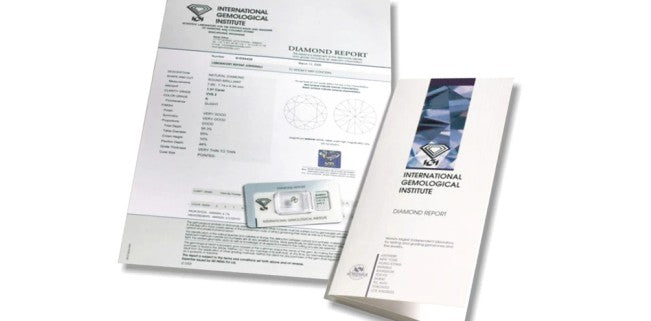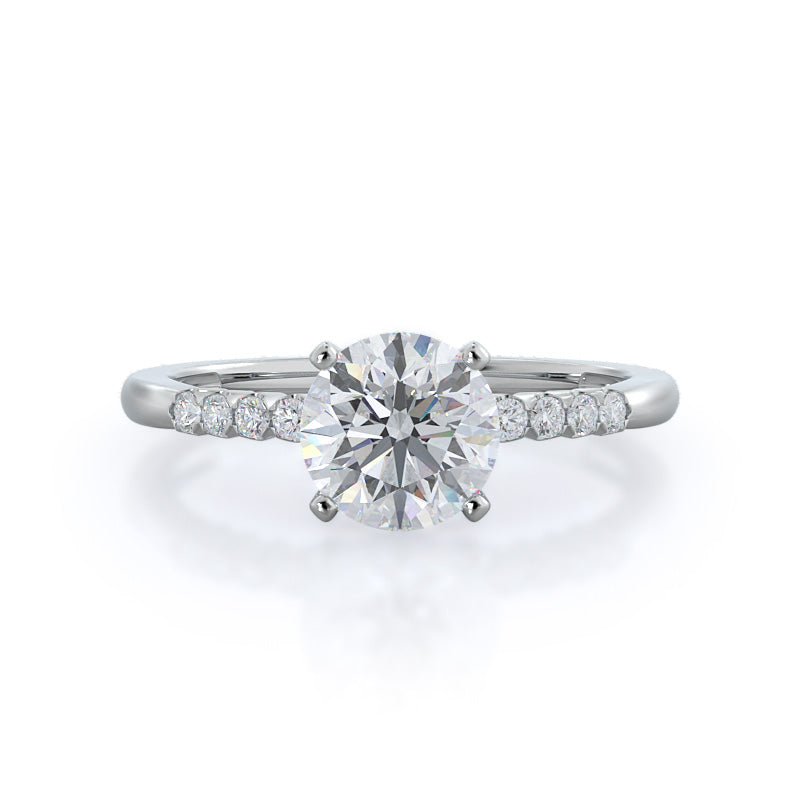Everything You Need to Know about Buying a Lab Diamond Ring
Lab grown diamonds provide consumers with a “real” diamond that shares the same chemical composition, optical properties and physical features as natural diamonds. Keep reading to learn more about With Clarity lab grown diamonds including benefits, pricing and how to select the perfect stone and setting.
TABLE OF CONTENTS
What is a Lab Grown Diamond?
The process to create a lab grown diamond is similar to the process to create natural diamonds - the only difference is one occurs within the earth's crust and the other occurs in a laboratory. To create a lab grown diamond, the manufacturing process replicates conditions that create a natural diamond creation - extreme temperatures and pressures that turn carbon into a diamond.
Manufacturers have two ways to create lab diamonds - High Pressure High Temperature (HPHT) and Chemical Deposition (CVD):
Jewelry can be engraved any time, either during or after purchase. If the jeweler is unable to do ring engraving, they should be able to direct you to an engraver. Some world-renowned grading labs, like the Gemological Institute of America (GIA), also perform special gemstone engraving. If you're not partial to the idea of inscribing a visible message, consider engraving the message on the gemstone itself. The GIA can laser-inscribe a microscopic message or graphic on the diamond, creating a special hidden message privy to just you and your partner. A laser-inscribed message also serves as a foolproof identifier in case your jewelry is ever lost or stolen.
HPHT: A diamond “seed” is added to carbon. A diamond seed is a small natural diamond fragment that can undergo both extreme temperature and pressure conditions. The HPHT diamond growth process subjects diamond seed and carbon to extreme temperatures (in excess of 1,300-1,600 degrees celsius) and pressures (one million pounds per square inch) to replicate the extreme heat and pressure conditions deep within the earth where natural diamonds form. The carbon forms around the diamond seed and is then cooled.
CVD: The chemical vapor deposition system begins with a diamond “seed.” It's important to select the strongest and highest grade (in color and clarity) natural diamond bit. During the CVD process, the vacuum chamber in which the diamond seed is placed fills with gases that are heavy in carbon and is then heated to well over 1,000 degrees. The intense heat then turns the gases into “plasma.” The plasma is what helps “build” the layers of the diamonds.
Each lab diamond takes about a month to produce and then it's cut and polished like a natural diamond.
Common Lab Grown Diamond Myths
A common myth about lab grown diamonds is that they're not “real” diamonds. However, lab grown diamonds have the same optical, physical, and chemical properties as a natural diamond.
Another myth is that lab diamonds are imitation diamonds, which is untrue. Actual imitations like cubic zirconia or synthetic moissanite look like diamonds but have different chemical and physical properties.
Lab Grown Diamond Benefits
Lab grown diamonds have numerous benefits in addition to cost, which we will discuss shortly:
Durability: They remain the hardest material on earth—a 10 on the Mohs hardness scale—and are as difficult to chip as a natural diamond.
Ethically Sourced and Conflict Free: Unlike most natural diamonds, you can pinpoint the origin of lab grown diamonds.
Environmentally Friendly: The environmental impact is much reduced, mined diamonds have a huge impact upon environments, landscapes and communities.
Lab grown diamonds have plenty of pros, but they aren't as valuable long-term as natural diamonds because natural diamonds are rare.
Lab Diamond Pricing
Lab grown diamonds are more affordable in comparison to natural diamonds. You can expect to pay 15% to 30% less on a lab diamond than you would on a mined diamond. This price difference is because mined diamonds go through a longer supply chain and require more costly resources.
| Shape | Carat Weight | Cut | Color | Clarity | Polish | Symmetry | Price |
|---|---|---|---|---|---|---|---|
| Round | 1 | Excellent | H | VS2 | Excellent | Excellent | $1,134 |
| Princess | 1 | Excellent | H | VS2 | Excellent | Excellent | $331 |
| Cushion | 1 | Excellent | H | VS2 | Excellent | Excellent | $1,143 |
| Radiant | 1 | Excellent | H | VS2 | Excellent | Excellent | $760 |
| Emerald | 1 | Excellent | H | VS2 | Excellent | Excellent | $602 |
| Oval | 1 | Excellent | H | VS2 | Excellent | Excellent | $547 |
| Pear | 1 | Excellent | H | VS2 | Excellent | Excellent | $860 |
| Marquise | 1 | Excellent | H | VS2 | Excellent | Excellent | $673 |
Some Tips and Factors for Shopping Include:
Lab grown diamonds are evaluated using the same color, cut, carat and clarity scales that natural diamonds are, so review this information while shopping for stones.
Ensure that your diamond ring purchase is protected by a return policy and lifetime warranty.
Pricing is less expensive and selection is wider online.
Ensure the lab grown diamond is IGI certified.

Setting Options:
You have plenty of setting options for lab grown diamond engagement rings. Some of the most popular ring settings are:

Classic Six Prong Solitaire Diamond Engagement Ring
An eternal classic, this best selling 6-prong engagement ring setting focuses all the attention to your stunning solitaire diamond.

Ridged Pave Diamond Engagement Ring
This dazzling ring features 0.10cts of pave set accent diamonds that are ridged and slightly elevated to accent this classic setting.

Luminous Six Prong Solitaire Diamond Ring
Designer Luminous Six Prong Solitaire Diamond ring with small windows on the head to let light penetrate your center gemstone for maximum sparkle.
With Clarity round brilliant stones continue to be the most popular cut. However you can find plenty of fancy shaped lab grown options if your significant other prefers an oval, cushion, pear, marquis, emerald or another cut.
Browse With Clarity's engagement ring styles to get some ideas. You have a few different options to meet your needs:
Custom Rings: With Clarity expert designers and gemologists blend art, science and technology to bring you the perfect engagement ring. We take any sketch, image, or sample and bring it to life with 3D computer models, 3D printed wax renders, and our eco-friendly gold and platinum metals.
Craft a Ring (3-Step Building Process): Choose your setting, then your diamond, and complete your ring to create the perfect ring for your special someone.
Preset Rings: With Clarity preset rings are crafted with care with the perfect blend of design and diamond sparkle. Simply customize for ring size and engraving and have the perfect ring ready for your proposal in a few days. It's a guaranteed yes.
With Clarity offers Perfectly Paired Wedding Bands: with our signature engagement ring designs, so each wedding band is a perfect match. Like natural versus lab grown diamonds, the difference between a lab diamond wedding band and natural diamond wedding band is the origin of the diamond.
Metals
Popular metals for lab grown engagement rings include white, rose, and yellow gold and platinum. By choosing a new engagement ring setting, you can customize it in thousands of ways including the metal setting: 14K or 18K white, rose or yellow gold or platinum.
FAQs
Are Lab Grown Diamonds Rings Real?
Are Lab Diamond Rings costlier than Natural Diamond Rings?
Can anyone tell the difference between a natural diamond ring and lab grown diamond ring?
How common are lab grown diamond rings?










